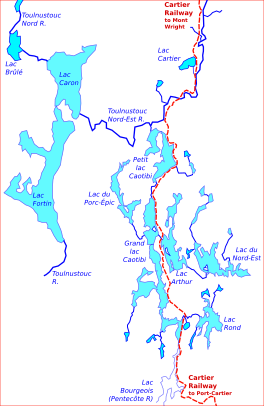Lake Arthur (Quebec) facts for kids
Quick facts for kids Lake Arthur |
|
|---|---|

South of the Northeast Toulnustouc River basin. Lake Arthur to the east of the Cartier railway
|
|
| Location | Sept-Rivières Regional County Municipality, Quebec |
| Coordinates | 50°45′30″N 67°31′53″W / 50.758341°N 67.531271°W |
| Native name | Lac Arthur Error {{native name checker}}: parameter value is malformed (help) |
Lake Arthur (French: Lac Arthur) is a beautiful lake located in Quebec, Canada. It's found within the Port-Cartier–Sept-Îles Wildlife Reserve in the Côte-Nord region. This lake is well-known for its large brook trout, making it a popular spot for fishing enthusiasts.
Contents
Discover Lake Arthur
Lake Arthur is a cool spot located in Quebec, Canada. It's part of the Port-Cartier–Sept-Îles Wildlife Reserve, which is a huge protected area. This lake is about 100 kilometers (about 62 miles) northwest of a town called Port-Cartier.
It's in a wild, unorganized area known as Lac-Walker. This area is part of the Sept-Rivières Regional County Municipality. Lake Arthur is quite big, covering about 11 square kilometers (around 4.2 square miles). It's famous for its large brook trout, making it a favorite place for fishing.
Where the Water Flows
Lake Arthur is connected to other lakes and rivers. Its water flows into Grand lac Caotibi, which is just to its west. From there, the water travels north into Petit lac Caotibi. Finally, it reaches the Rivière Toulnustouc Nord-Est. This river eventually joins the Toulnustouc River basin.
You'll also find the Cartier Railway running right between Lake Arthur and Grand lac Caotibi.
How Lake Arthur Got Its Name
Lake Arthur is named after a man named Arthur A. Schmon. He lived from 1895 to 1964 and was from Newark, New Jersey, in the United States. Arthur Schmon was a very important person in the paper industry. The lake was officially given his name on December 5, 1968.
Visiting Lake Arthur
If you love nature and outdoor adventures, Lake Arthur is a great place to visit! The Port-Cartier–Sept-Îles Wildlife Reserve operates a campsite right by the lake. You can get there by following the road that runs along the south side of the lake.
There are 29 camping sites available for visitors. While there isn't drinking water directly at the sites, you can find showers and even rent a boat to explore the lake. If you prefer something more comfortable than a tent, there are also cottage accommodations.
The reserve charges a daily fee to use the site. In 2017, the Quebec government announced that a new type of cottage, called a Modik cottage, was being built at Lake Arthur. These wooden cottages are designed for fishing fans and can hold up to four adults. They are also built to use mostly solar energy, which is great for the environment!


